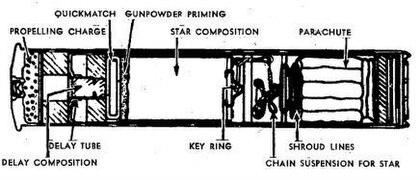Ammunition
The primary roles for the Kampfpistole were signaling, illumination, target marking, or concealment with a smoke grenade. Later during World War II, explosive rounds were developed to give German troops a small and lightweight grenade launcher for engaging targets from close range which could not be engaged satisfactorily by infantry weapons or artillery without endangering friendly troops. [2]
Available projectiles included:
- Fallschirm Leuchtpatrone - This was a non-lethal parachute retarded flare that could be used for battlefield illumination or as a signal flare. The projectile can be identified by its "F. Leucht. Z." marking on the base of the projectile. [3]
- Nebelpatrone - This was a non-lethal smoke grenade with a nose fuze that could be used for target marking or concealment. It was similar in appearance to explosive grenades and could be identified by its "NEBEL. Z" marking on the base of the projectile. [3]
- Sprengpatrone - A nose fuzed high explosive grenade that was used for low angle direct fire where range and accuracy were needed. It was not recommended for use beyond 180 m (200 yd) due to inaccuracy or less than 46 m (50 yd) due to the risk from shell fragments. [2]
This page is based on this
Wikipedia article Text is available under the
CC BY-SA 4.0 license; additional terms may apply.
Images, videos and audio are available under their respective licenses.



